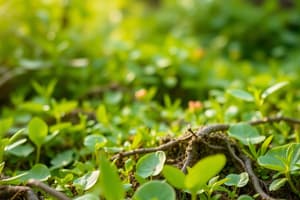Podcast
Questions and Answers
What are the two types of selection pressures that affect ecosystems?
What are the two types of selection pressures that affect ecosystems?
Biotic and abiotic selection pressures
Which of the following is a positive selection pressure that can affect the abundance of an organism?
Which of the following is a positive selection pressure that can affect the abundance of an organism?
- High food availability (correct)
- High competition
- Disease organisms
- Presence of predators
Which abiotic factor is NOT mentioned as affecting ecosystems?
Which abiotic factor is NOT mentioned as affecting ecosystems?
- Presence of competitors (correct)
- Salinity
- Light intensity
- Availability of water
Negative selection pressure leads to an increase in the abundance of organisms.
Negative selection pressure leads to an increase in the abundance of organisms.
What can be a long-term consequence of selection pressures on a population?
What can be a long-term consequence of selection pressures on a population?
The ______ was introduced into Australia and took up 10% of agricultural land.
The ______ was introduced into Australia and took up 10% of agricultural land.
Cane toads in Australia have natural predators that control their population.
Cane toads in Australia have natural predators that control their population.
Match the following ecosystems with their key abiotic factors:
Match the following ecosystems with their key abiotic factors:
What is one short-term consequence of selection pressures?
What is one short-term consequence of selection pressures?
Study Notes
BIOTIC SELECTION PRESSURES THAT AFFECT ECOSYSTEMS
- Environmental factors include food availability, presence of predators, competitors, disease organisms, and human influence.
- Biotic factors can originate from the same species or different species.
- Positive selection pressure increases organism abundance, while negative selection pressure decreases it.
ABIOTIC SELECTION PRESSURES THAT AFFECT ECOSYSTEMS
- These can be physical (like light intensity, temperature) or chemical (such as availability of oxygen and carbon dioxide).
- Key abiotic factors: water availability, soil characteristics, light intensity, temperature range, and salinity.
- Similar to biotic factors, positive selection pressure leads to increased abundance, while negative results in decreased numbers.
Effects of Selection Pressures
- Influences the survival rates of organisms.
- Affects population abundance.
- Impacts overall ecosystem diversity.
- Drives evolutionary changes in species.
Ecosystem Specific Selection Pressures
-
Desert Ecosystem
- Abiotic: Less than 250 mm rainfall, high daytime temperatures (up to 40°C), low nighttime temperatures (0°C), often sandy soil.
- Biotic: Sparse grasses and salt bushes, species like Spinifex hopping mouse, various insects.
- Example of pressure: Lack of water leads to adaptations that minimize surface area.
-
Tropical Rainforest Ecosystem
- Abiotic: More than 1500 mm rainfall, high humidity, mild to high temperatures.
- Biotic: Diverse species of mammals and insects inhabiting various habitats.
- Example of pressure: Trees competing for light with broad foliage.
-
Saline Environments
- Abiotic: High salt levels affect life forms.
- Biotic: Halophytes like mangroves that adapt to saline conditions.
- Example of pressure: Adaptations to thrive in high salinity environments.
Population Changes Due to Selection Pressures
- Prickly Pear Case
- Originally introduced in Australia, occupying 10% of agricultural land.
- Control measures included introducing a moth to reduce cactus populations.
- Short-term effects: Death and population reduction.
- Long-term effects: Adaptation and potential population growth.
CANE TOADS IN AUSTRALIA
- Introduced for biological control of cane beetles but proved ineffective.
- Characteristics: Absence of natural predators, high reproduction capacity, adaptable diet, well-suited to the environment.
- Increased cane toad populations exert strong selection pressure on native Australian marsupials.
Studying That Suits You
Use AI to generate personalized quizzes and flashcards to suit your learning preferences.
Related Documents
Description
Explore the impact of environmental pressures on the diversity and abundance of species in ecosystems. This quiz covers biotic selection pressures such as food availability, predators, and human influence, examining how these factors contribute to selection pressures and ecological balance.




